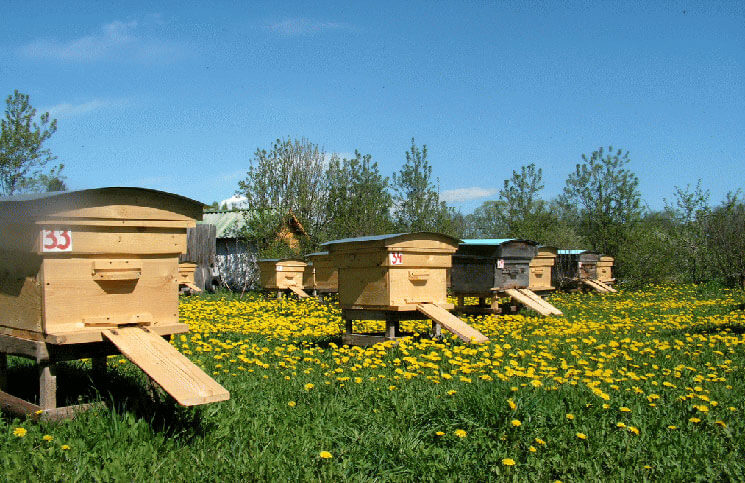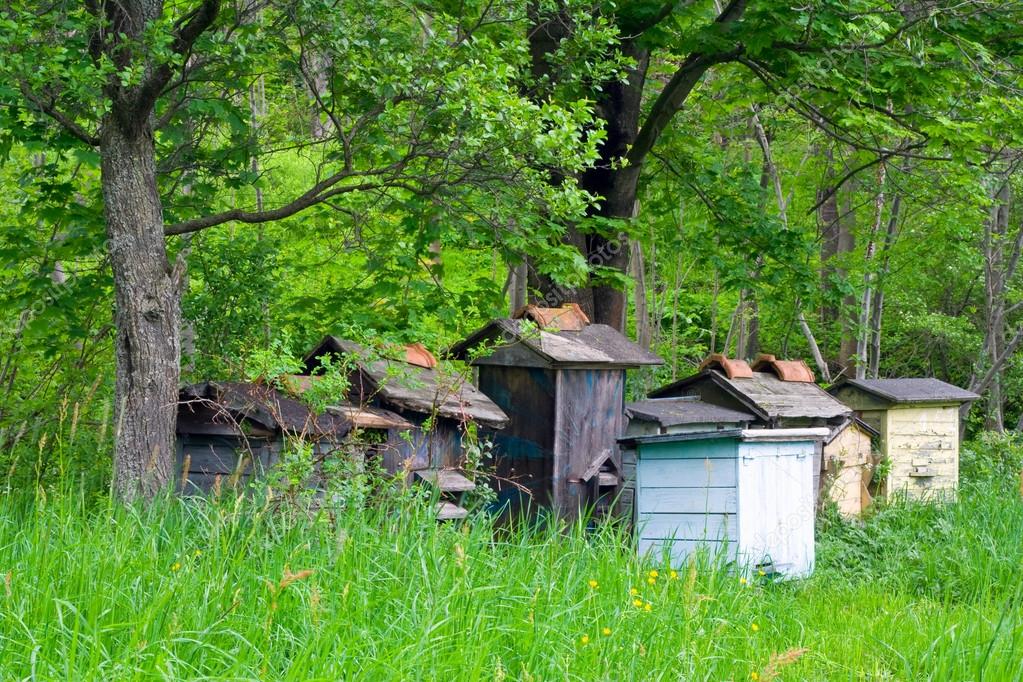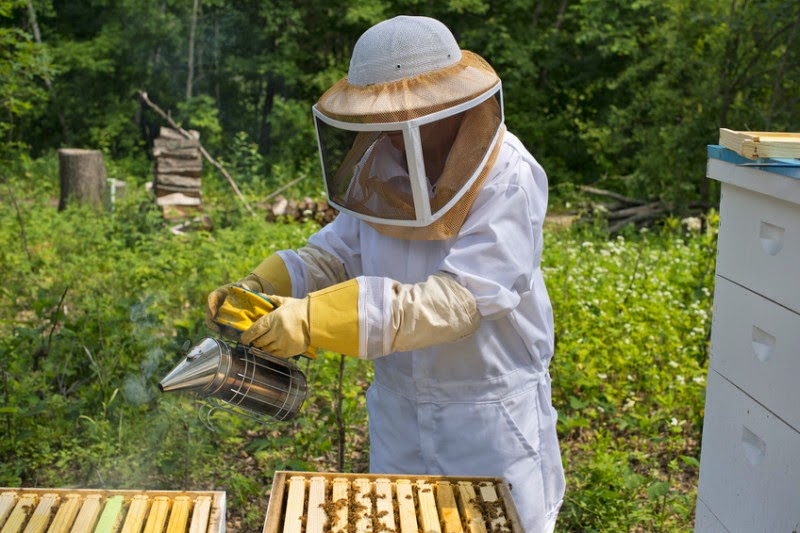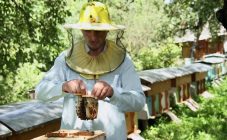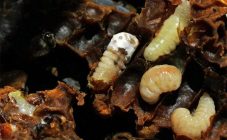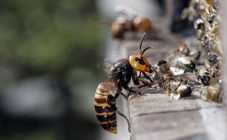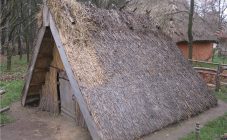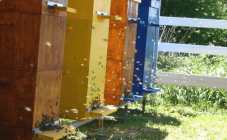Content:
Beekeeping is a profitable business with high profitability and an excellent payback rate, even in difficult times of crisis.
But many beekeepers start their apiary not for profit, but as an interesting and useful hobby, which then develops into a bee business.
What is an apiary
An apiary is a piece of land with hives located on it, in which bee colonies live. Their number usually depends on the number of melliferous crops growing in a particular area.
In addition to hives, the equipment required for an apiary includes:
- drinkers for bees;
- a technical room for storing inventory, containers and honey pumping;
- a set of tools (smoke, honey extractor, wax extractor, swarms, etc.)
If the new apiary is large enough, it may have a park of small hives (cores) used for hatching and fertilization of queen bees.
The hives can be located in different ways: in bulk (on the ground) or in a bee hive (stationary or mobile).
Obtaining an apiary passport
Having dealt with the fact that such an apiary and its definition, special attention should be paid to obtaining a veterinary passport for it.
In order for the work of the beekeeper in the apiary to start paying off, it will need to be properly formalized and registered.
An apiary passport is understood as a document that gives the right to sell beekeeping products and carry out any actions with bees.
Considering the above question: how to get an apiary passport is an acute issue for most novice beekeepers.
In this case, the paperwork should not be considered an empty and unnecessary formality. The veterinary and sanitary passport contains significant information concerning the beekeeper (age, gender, name, place of residence) and apiaries (health of bees, keeping conditions, composition of honey plants).
Every beekeeper must have this document, regardless of the form of ownership of his farm.
For registration, you will need to submit an application to the veterinary station. A sample application can be found freely on the Internet without much difficulty. There is also information regarding the procedure for providing a land plot for placing an apiary.
After receiving an application for a bee apiary, a specialist is sent to inspect the farm. Its main task is to take samples from bee hives, visually inspect the farm and transfer the collected materials to the laboratory.
In the absence of comments from the person who inspected the apiary at the dacha or a suburban area and satisfactory test results, the beekeeper is issued an appropriate conclusion, the farm goes through registration, which ends with the issuance of a passport.
If in the course of the inspection inconsistencies are found, and the laboratory detects diseases of the bees, the beekeeper is given recommendations for eliminating the inconsistencies and the correct arrangement of the apiary. Later, a re-request for verification and analysis may be sent.
The legislation regulates the annual conduct of this kind of inspections. According to their results, a corresponding mark is put in the passport. A new document is required in two main cases:
- when changing the owner;
- on the fact that all pages are filled and there is no space for planned records.
Placement of an apiary in a recreational area
Novice beekeepers should know that there is no possibility of placing an apiary in a recreational area as such. It is not allowed to place hives closer than half a kilometer from roads and railways.
If you plan to breed bees in the country, then the following rules should be strictly observed:
- do not install hives at a distance of less than 3 meters from the border with a neighboring land plot;
- the direction of the entrance should not be in the direction of neighboring lands;
- the perimeter of the apiary should be fenced off with a fence or hedge at least two meters high.
In addition, if a bee apiary is planned on a private territory where there are relatively close neighbors, it is recommended to interview them even, if not for agreement with the placement of the apiary, then at least for the absence of an allergic reaction to the bites of these honey insects.
The procedure for providing land for an apiary
Land plots for beekeeping are provided to individuals and legal entities, in accordance with the current legislation, for the period of flowering of honey plants, regardless of the place of registration of bee colonies.
If we are talking about the placement of hives in summer cottages and in horticultural cooperatives, in this case, the procedure is regulated by the constituent documents of non-profit associations.
Nomadic apiaries are placed at the sources of honey collection at such a distance from other apiaries, which ensures productive maintenance of bee colonies and effective pollination of agricultural entomophilous plants. Accommodation not allowednomadic apiaries on the path of summer bees with another previously postedapiaries to the sources of honey collection.
A citizen and a legal entity, after placing a nomadic apiary, are obliged to report information about it and present the apiary's veterinary and sanitary passport to local authorities. Accommodationhives with bee colonies in horticultural, vegetable gardening or dacha non-profit associations is regulated by their constituent documents.
Arrangement of an apiary
Having dealt with the concept of an apiary and understanding what it is, you should turn to the issue of arranging a beekeeping farm in more detail, depending on its specifics.
Apiary in the forest
In order for the forest version of the apiary to bring a maximum of useful honey and a minimum of loss, the organization of the economy should be approached thoroughly. It is imperative to make sure that the flowering melliferous plants are close, so that the bees do not have problems finding nectar.
Apiaries in the forest can be permanent or temporary (transferred from place to place). In both cases, when organizing a farm, it is recommended to observe the following rules:
- Placing hives deep in the forest is not the best option. For this purpose, an open clearing directly at the entrance to the forest zone is more suitable.
- It is important to ensure that flowering plants are present in and around the selected area for most of the warm season, and not just for a very limited amount of time.
- It should be remembered about the possibility of a negative impact of natural factors. Hurricanes and windbreaks can damage hives and lead to the complete loss of bee colonies.
- An acceptable road should lead to the apiary site. Otherwise, the farm will be inaccessible in bad weather.
Apiary in the country
An apiary in the country is the dream of many. Breeding bees in the conditions of summer cottages assumes that the apiary meets the following requirements:
- the distance from the hives to the neighboring plot should not be less than ten meters;
- if the dacha is located in a settlement (a village, a dacha cooperative is also considered), it is not allowed to establish more than two families per 100 sq. m. (that is, it will be very problematic to start an apiary with 145 frames);
- a two-meter fence should be installed at the summer cottage;
- the distance between the hives should be three meters.
Bees in the country will bring additional benefits to the garden, since insects will pollinate trees and other plants on the site, thereby contributing to an increase in their yield.
Experts in such an area as beekeeping recommend choosing non-aggressive varieties of bees for a summer apiary. For example, the same Transcarpathian bee is famous among beekeepers for its peacefulness and almost complete absence of aggression towards the beekeeper.
Apiary under the roof
Everyone knows what an apiary is, but not everyone has heard about the so-called attic beekeeping. Practice shows that the ground is not the only place where hives can be installed.
Placing bee houses under the roof of various structures, be it a garage or a barn, allows insects to lay their own air route, which is located in an area that is completely safe for humans.
An apiary under the roof of a house is most often equipped in conditions of a shortage of territory. For this kind of insect containment, relatively small twelve-frame hives are best suited. You can also use standard multi-hull structures, the modification of which allows installation in several tiers.
The attic beekeeping method has the following advantages:
- increasing the productivity index of the apiary as a whole;
- the maintenance of such an apiary is safe for both people and pets;
- no negative influence of weather and time of day (working in an apiary in July with good weather or in September during the rainy season can be done with equal success);
- lack of sudden temperature changes;
- increasing the durability of the hives (in such conditions, even houses with thin plywood walls will last long enough);
- during the wintering of bees, it is possible to regulate the air temperature using electric heaters.
The holes can have an exit in one direction. But, if there are more than 10 bee colonies, it is worthwhile to provide for the entrance gaps in two walls. In this case, they should be directed towards the east and west.
Apiary in the barn
Keeping bees in a barn is not much different from beekeeping in an attic. Moreover, hives are also recommended to be placed under the ceiling. More often sheds and garages are used not so much for organizing an apiary as for organizing a comfortable winter for insects.
Nevertheless, those who equip an apiary in a shed or any other enclosed space, note that there is no need to bring hives into the winter house in the fall, take them out in the spring and transport the bees to the points.
In addition, the shed provides insects with reliable protection, both from bad weather and from temperature extremes. The most important thing is to try to create the most comfortable living conditions for the bee families. To do this, you will need to insulate the walls, making them not ventilated. In winter, the temperature in the barn should not be lower than +5 degrees.
Beekeeping is a very exciting field of activity. If someone shows interest in beekeeping, he should definitely try his hand.After all, it is not difficult to organize a modest apiary for a couple of families.


